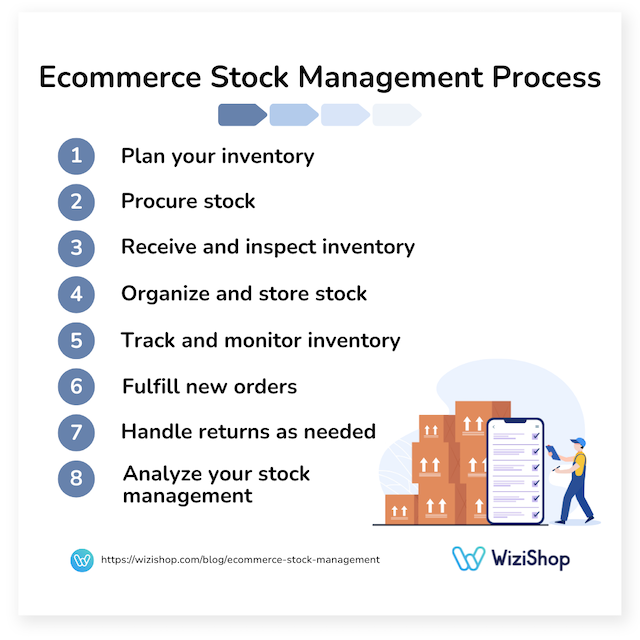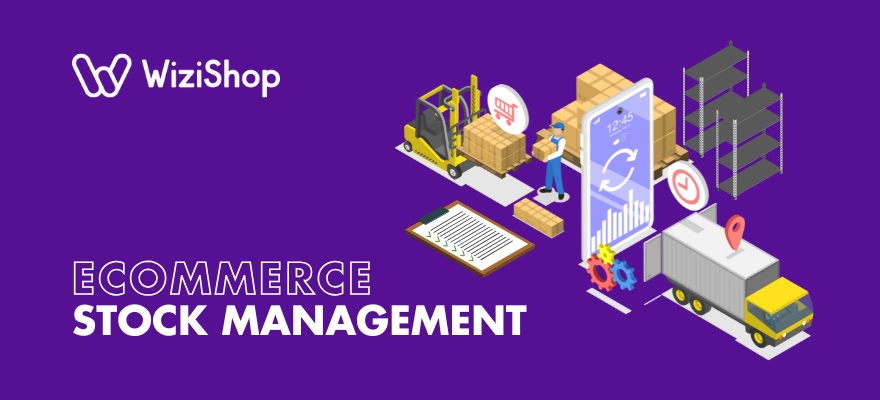For commercial and ecommerce companies, stock management is a key concern. Good organization of product storage perfectly meets customer expectations, while reducing costs and boosting operational performance.
So, how about acquiring a solid logistical grounding in this aspect of your web commerce business in order to better manage your ecommerce site? In this article, we will take a look at the fundamentals of stock management, its objectives and challenges, and the best methods for optimizing the goods you sell and your customers' orders.
Table of contents
- What is stock or inventory management?
- What are the objectives of good inventory management for companies?
- How does the process of ecommerce stock management work?
- What are the challenges of managing product stock for ecommerce businesses?
- How is inventory management optimized via different techniques?
- How can small businesses optimize and improve procurement?
- Ecommerce stock management FAQ
What is stock or inventory management?

Definition of stock
Stock refers to all goods held by a business at a given point in its production or distribution process. To manage your business's inventory correctly, you must distinguish between the different categories of goods you need to consider:
- Raw materials: the basic elements essential to the production of your products
- Semi-finished products: goods that have undergone an initial transformation but still require several stages to become perfectly finished products
- Finished products: items ready for sale to consumers
- Safety stock: additional reserves held to meet uncertain customer demand or lead times
- Seasonal stock: products intended for sale during a specific period of the year
All this stock needs to be managed intelligently. The aim is to enable you to easily retrieve the products you need, while optimizing storage space.
Well-organized stock minimizes unnecessary movement around the warehouse, speeds up order picking, and reduces the risk of product spoilage.
Importance of storage
Optimal stock management is a key factor in any business, and its impact can be felt in a number of ways. In particular, inventory management has an impact on the following:
- Customer satisfaction: Well-organized inventory ensures better availability of products when buyers need them, thus avoiding delivery delays and stockouts that can frustrate and/or disappoint your customers. Good management also boosts customer satisfaction, while reinforcing your business's reputation and brand image.
- Profitability: Good inventory management reduces the costs associated with storing and managing products. A well thought-out strategy prevents overstocking and all the associated costs. At the same time, it also prevents understocking, which can be costly and disastrous for a business from a purely commercial point of view, as happens when sales opportunities are missed and customers possibly lost due to stockouts.
- Operational efficiency: Well-managed warehousing facilitates order picking, inventory management, and ecommerce and/or global logistics. This saves the business time and makes better use of resources by reducing picking errors, while ensuring a smoother flow of goods.
What are the objectives of good inventory management for companies?

To be efficient, a company needs to focus its efforts on a number of different aspects. Inventory management is one of them! It is directly linked to the performance of the structure as a whole, and meets a number of objectives.
Serve the customer as best as possible
The first objective of inventory management is to satisfy customers, by providing them with the products they need, when they need them: products sold must be readily available. In this way, you can minimize order preparation and delivery times for faster fulfillment.
Inventory management will also need to be adapted to fluctuations in customer demand. This means anticipating periods of high activity and adjusting stock levels accordingly.
Logically, if your digital commerce business is selling hats, for example, there's a good chance that they will be more popular with customers in winter. Your stock must therefore be ready to meet the sudden influx of orders!
But beware: excess stock is totally counterproductive!
Overstocking entails additional storage, handling, and insurance costs. On the other hand, understocking can lead to costs associated with late deliveries and stockouts. It's best to find the right balance to avoid lost sales for your business. Your goal? To have exactly the right level of stock to respond rapidly to market popularity.
Risks associated with inventory management
- Consequences of overstocking
In the case of overstocking, money is invested in products that won't sell immediately. This ties up capital, and the larger the stock, the more storage space it requires. But warehouses are expensive! An immediate impact on business profitability. If you have too much stock, especially if your products are perishable, you need to be very careful: products that you keep for too long can become obsolete, which will result result in dry financial losses.
- The consequences of understocking
Understocking can lead to stockouts. Not only does it have a direct impact on buyer satisfaction, but it can also lead to additional costs for your web commerce business: urgent purchases, express shipping, late penalties for not meeting deadlines, etc.
How does the process of ecommerce stock management work?
Here’s a high-level overview of the main steps in the ecommerce stock management process:

- Plan your inventory: Use historical sales data, trends, and seasonal insights to estimate future product demand. You can then plan stock levels accordingly to avoid overstocking or stockouts.
- Procure stock: Based on forecasts, place orders with suppliers to restock inventory. Be sure to establish reorder points and minimum stock levels to trigger timely restocking.
- Receive and inspect inventory: When stock arrives, inspect it for quality and quantity to ensure it meets order specifications. Log and update inventory in the system to maintain accurate stock records.
- Organize and store stock: Store products in an organized, accessible way, likely with the help of a warehouse management system (WMS). Aim to optimize your warehouse layout to improve picking efficiency, especially for popular items.
- Track and monitor inventory: Track stock levels in real-time across all sales channels. Use inventory management software to update records automatically and avoid discrepancies.
- Fulfill new orders: When customers' orders are placed, locate items in the warehouse and pick, pack, and ship them efficiently. Ensure that stock levels are updated after you ship orders to reflect current inventory.
- Handle returns as needed: Manage product returns by inspecting items and deciding if they can be restocked, refurbished, or discarded. Keep in mind that you'll then need to update inventory records accordingly and process refunds or exchanges as necessary.
- Analyze your stock management: Regularly analyze stock performance, including turnover rates, aging stock, and forecast accuracy. Next, use your insights to refine future demand forecasts, procurement plans, and warehouse organization.
Each of these steps works together to maintain an efficient, responsive, and accurate stock management system for ecommerce.
What are the challenges of managing product stock for ecommerce businesses?

Managing stock for digital commerce businesses comes with a unique set of challenges, regardless of the products they sell, particularly due to the fast-paced and often unpredictable nature of online sales. Here are some of the main hurdles that ecommerce businesses face.
Demand forecasting
Predicting demand is especially tricky online, where trends can shift quickly due to viral marketing, seasonality, and influencer-driven sales. A sudden spike in demand can lead to stockouts, while overestimating can result in unsold inventory.
Utilizing data analytics and demand forecasting tools and software helps, though these require constant updating and refinement as consumer behaviors evolve.
Inventory visibility
It’s crucial to have real-time visibility into stock levels across multiple channels and warehouses, especially if an ecommerce business sells on multiple platforms (like Amazon, eBay, and its own website). Without this, it’s easy to oversell or undersell.
Integrating inventory management systems (IMSs) can synchronize stock levels across channels, but keep in mind that this requires investment and careful implementation to avoid syncing errors.
Inventory holding costs
Storing inventory incurs costs, such as warehousing, utilities, and staffing. Over-ordering or slow-moving inventory increases holding costs, especially problematic for businesses with thin margins.
Balancing stock levels and optimizing warehouse space can mitigate costs, but businesses must also work to streamline SKU selection and potentially negotiate with suppliers to offer more flexible restocking options.
Supplier and lead time management
Ecommerce businesses often rely on suppliers across different regions, which means varying lead times and potential for delays. This complicates stock management, especially when suppliers face shortages or shipping disruptions.
Diversifying suppliers and maintaining close relationships with them can help improve reliability, though it also requires careful vendor management and regular performance monitoring.
Returns and reverse logistics
Compared to brick-and-mortar stores, ecommerce websites tend to have higher return rates, especially in categories like fashion. Managing these returns effectively while minimizing loss can be complex and costly.
Streamlining the return process and assessing returned goods for resale potential can reduce losses, but this requires efficient reverse logistics processes and robust return policies.
Warehouse organization and fulfillment efficiency
As inventory grows, so does the complexity of organizing and picking stock efficiently. Poor warehouse organization leads to slower fulfillment times, higher labor costs, and sometimes incorrect order shipments.
Implementing a warehouse management system (WMS) and optimizing layouts for high-demand items can help streamline fulfillment.
Data accuracy and syncing
Data discrepancies between sales channels and inventory records lead to inaccuracies, often resulting in stockouts or overselling. This can be exacerbated by manual inventory updates, which are prone to errors.
Automating data syncing and having periodic audits for stock accuracy can reduce these issues, though ongoing monitoring is necessary to ensure that the information remains accurate.
How is inventory management optimized via different techniques?

Economic order quantity (EOQ) in inventory management
Economic order quantity in inventory management is based on calculating the optimum quantities to stock, taking into account various parameters such as the number of orders or procurement lead times.
There are a number of different approaches to determining the quantities of stock you need:
- Order point (also known as “replenishment stock”): In supply chain management, this is the stock level at which a new order must be placed. In other words, it's the minimum level below which you need to restock;
- Economic lot: This technique involves determining the optimum size for each order to minimize costs;
- ABC method: In this case, you simply place items according to their value, to concentrate your main logistical efforts on the most important products.
Of course, whichever method you choose, you will need to think ahead! Accurate demand forecasting is essential for good inventory management, especially in ecommerce. Use statistical methods and analyze past trends to predict future needs. To help you anticipate variations in demand, we recommend the use of inventory management forecasting software.
Periodic inventory management
Periodic inventory management consists of performing regular physical stocktaking at precise intervals. This provides an opportunity to assess the cost of goods sold and to verify the relationship between the stock actually present in the warehouse and the accounting data recorded.
Depending on the company, a physical inventory is carried out at different frequencies. When discrepancies are found between the information in the collection and the accounting records, this means that the company is experiencing theft, management problems, or data entry errors.
Barcode-based inventory management
Barcodes enable a unique number to be assigned to each product sold, facilitating tracking and management. In fact, the barcode refers directly to the product name, price, reference number, and so on. As new barcodes come in and out of stock, and as they are scanned, the stock management system is automatically updated. This provides better product traceability and real-time updating, and it can also help prevent manual data entry errors.
Inventory management with RFID
Radio frequency identification (RFID) technology is a new technique that offers even faster automatic recording of receipts and deliveries.
RFID tags work in a similar way to barcodes and are embedded in every product. Unlike barcodes, RFID tags can be read remotely, enabling faster, automatic data capture.
This technology offers greater stock visibility and enables products to be tracked with extreme precision. Logistics flows are considerably improved.
How can small businesses optimize and improve procurement?

Importance of inventory
First of all, when it comes to inventory management, physical stocktaking enables us to identify more precisely those products that are not selling, or are selling very little. It prevents unnecessary overstocking, while revealing dormant stocks, i.e., items remaining in stock for a very long time without being sold.
When it's perfectly up to date, the inventory enables us to better plan purchases and prevent stockouts or overstocking. It also highlights signs of poor merchandise management or sales, so you can take corrective action if necessary.
Stocktaking method: Move to automation
Taking physical inventory is a long and tedious process. However, it can now be automated. Such a system enables inventory to be carried out more quickly and more accurately than with manual counting.
What's more, many automatic inventory systems are now integrated into company accounting software. As a result, inventory levels and costs of goods sold are perfectly matched. Everything is updated simultaneously, for better overall company management. This saves time and money, enabling better anticipation and minimizing the immobilization of capital.
Application, training, chart: Logistics tools & software
Ecommerce logistics tools enable you to receive replenishment alerts. Detailed management reports can even be generated, immediately facilitating decision-making and the identification of opportunities for improvement.
Did you know that some online sales platforms, such as the WiziShop platform, directly integrate ecommerce automation tools for inventory tracking? In fact, with us, this isn't an option... This automatic tool is directly included in your subscription! We give you all the tools you need to manage your inventory more effectively and optimize your online sales.
Our platform also provides over 400 integrations to boost your conversions, more than 50 SEO features to optimize your site's technical SEO, access to helpful Business Coaches to help you make the most of our software and answer any questions you may have about your online store, powerful AI to generate all different types of text content in a flash, and more.
Test the WiziShop platform and launch your future ecommerce business today!
Try WiziShop free for 7 days
THE EASIEST NO-CODE ECOMMERCE SOLUTION✅ No credit card required
✅ Access to all features
✅ No commitment
Ecommerce stock management FAQ
What is stock management in ecommerce?
Stock management in ecommerce involves monitoring, controlling, and optimizing inventory levels to meet customer demand efficiently. It includes forecasting, ordering, storing, and tracking stock across multiple sales channels, ensuring products are available while minimizing excess inventory. Effective stock management improves customer satisfaction, reduces costs, and maximizes business profitability.
What is an inventory management system?
An inventory management system (IMS) is software that helps businesses track, organize, and manage inventory levels, orders, and sales across channels in real time. It streamlines stock control, improves accuracy, prevents stockouts or overstocking, and enhances overall operational efficiency, crucial for effective inventory management.
How can tracking inventory for ecommerce be done?
Ecommerce sellers can track inventory by using an IMS that provides real-time updates across all sales channels. Businesses can also implement barcoding or RFID tagging to scan items as they move through the supply chain, updating stock records automatically.
In addition, syncing the IMS with ecommerce platforms ensures consistent, accurate stock levels, reducing the risk of overselling or stockouts. Periodic cycle counts help validate system data, while setting reorder points for each product ensures restocking at the right time. Finally, availing of data analytics can also help in forecasting demand and optimizing inventory levels.
What features should you look for when choosing inventory management software?
When selecting software to help you manage the inventory for your online store, besides pricing that suits your business's budget, you will want to make sure that it has several important features. Inventory management software should have real-time tracking to monitor stock levels across all sales channels, automation features for reordering, and integrations with ecommerce platforms, warehouses, and shipping systems.
It should also offer reporting and analytics to help forecast demand and manage stock performance. Multi-location support is essential for businesses with multiple warehouses, and barcode/RFID integration improves tracking accuracy. User-friendly interfaces and scalability are also key for growing businesses.
What’s the best way to handle inventory across multiple sales channels?
If your business has multiple points of sale, the best strategy for managing your inventory will be by using a centralized IMS that synchronizes stock levels in real-time across all platforms. This reduces the risk of overselling or stock discrepancies, as each sale updates inventory counts immediately. Furthermore, setting reorder points in the IMS helps automate restocking, ensuring timely fulfillment.
Integrating with shipping and warehouse management systems also streamlines fulfillment processes. Regularly reviewing sales data across platforms can then refine inventory distribution, aligning stock levels with channel-specific demand trends for your business.










